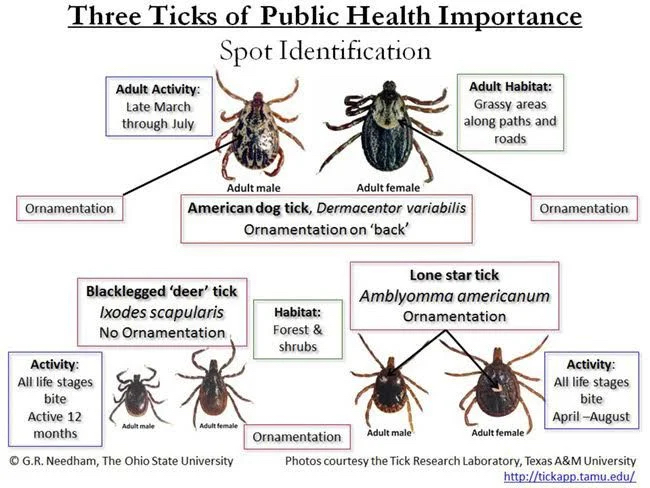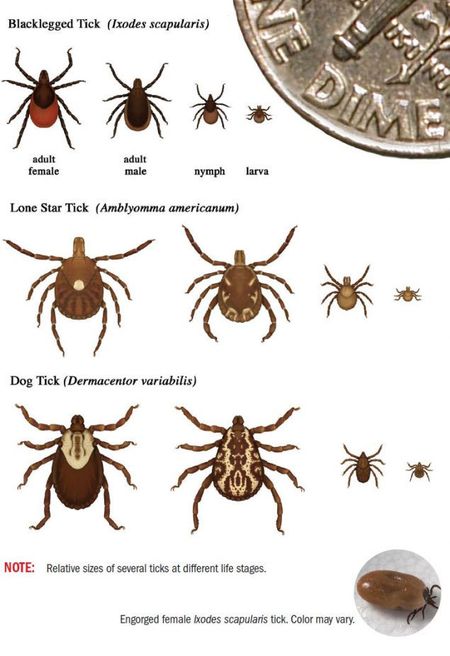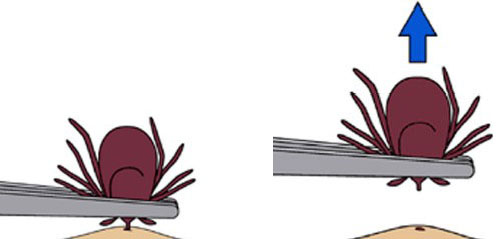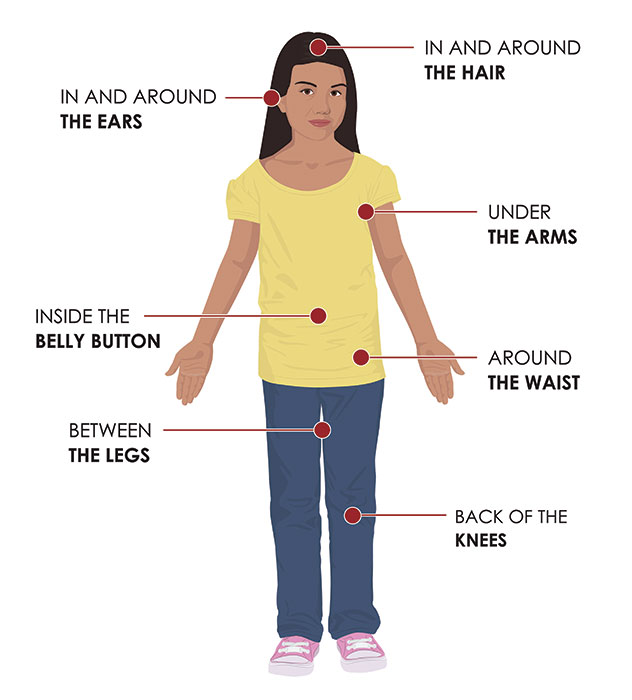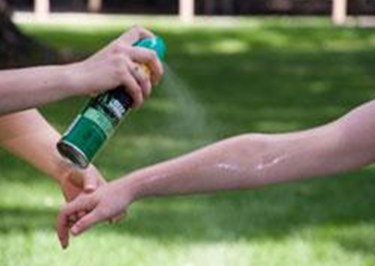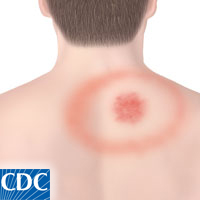Posts Tagged ‘Ticks’
Preventing Tick Bites: Tips for Enjoying the Outdoors Safely. By Our Student Pharmacist, Lee Zimmer.
This may be biased, but summers in Ohio are simply the best, that is, when it isn’t storming or blisteringly hot. As the summer season unfolds in central Ohio, many people may be eager to embrace the great outdoors and enjoy the amazing trails and metro parks around us. However, before you run out the door and start doing cartwheels, we should have a quick discussion about one of the potential health risks this season – tick bites. Ticks can carry diseases like Lyme disease and Rocky Mountain Spotted Fever and can pose a threat to not just our well-being, but to our pets as well. Forewarned is forearmed as they say, so don’t fret! In this blog post, we’ll provide you with valuable tips to prevent tick bites, ensuring you can safely enjoy your outdoor adventures.
- Know Your Enemy: Understanding Ticks and Their Habitats
To effectively prevent tick bites, it’s crucial to familiarize yourself with these tiny arachnids.
The three medically important tick species in Ohio are the:
- American dog tick
- Blacklegged tick (aka Deer tick)
- Lone Star tick
While some species can actually remain active throughout the entire year, the time of greatest activity for most tick species is from spring to fall. The American dog tick inhabits grassy areas along roads or paths, often next to wooded areas. The Blacklegged tick prefers wooded areas, while the Lone Star tick loves shady areas next to meadows and roadsides.
- Dress to Repel: Tick-Proof Clothing Choices
Wearing the right clothing can act as a barrier against ticks. Opt for long-sleeved shirts, long pants, and closed-toe shoes whenever possible. Tuck your pants into your socks or boots to minimize exposed skin. Additionally, choose light-colored clothing to spot ticks more easily.
- Tick Repellents: Safeguarding Your Skin
Apply an EPA-approved tick repellent to exposed skin and clothing. Look for products containing DEET (25% minimum), picaridin, or permethrin. Follow the instructions carefully, ensuring thorough coverage. Remember to reapply as recommended, especially if you’re engaging in prolonged outdoor activities.

- Tick-Proof Your Yard: Creating a Tick-Unfriendly Environment
Make your yard less appealing to ticks by implementing a few simple measures:
- Trim grass and vegetation regularly.
- Keep leaf litter and brush cleared.
- Create a barrier of wood chips or gravel between your yard and wooded areas.
Consider professional pest control treatments if necessary.
- Conduct Tick Checks: Thoroughly Inspect Yourself and Others
After spending time outdoors, perform a thorough tick check on yourself, family members, and pets. Pay close attention to warm areas like armpits, behind the ears, along the hairline, and between toes. Promptly remove any attached ticks using fine-tipped tweezers, grabbing as close to the skin as possible (you want to get the WHOLE tick), and clean the area with antiseptic.
Side note, please don’t attempt to burn ticks off of yourself or someone else. It feels pretty self-explanatory why that is a bad idea, but it needed said.
- Protect Your Pets: Tick Prevention for Furry Friends
Ticks pose a significant risk to our beloved pets. Consult your veterinarian to determine the most appropriate tick prevention methods for your furry companions. Options may include tick collars, topical treatments, or oral medications. Regularly inspect and groom your pets to catch any hitchhiking ticks.
- Educate Yourself: Recognizing Tick-Borne Diseases
Familiarize yourself with the signs and symptoms of tick-borne diseases prevalent in Ohio, such as Lyme disease spread by the Blacklegged tick. The Centers for Disease Control and Prevention (CDC) state that ticks need to be attached for 24 hours or more to transmit disease. If you experience any unusual symptoms (like fever or flu-like symptoms) within a few weeks of a tick bite, contact your health care provider and emphasize that you were recently bitten by a tick.
 With the right knowledge and preventive measures, you can enjoy the summer season while minimizing the risk of bites from these little blood suckers (and mosquitoes too, but that’s another topic for another day). Add these tips into your outdoor routine, educate others about tick prevention, and remember to check yourself and others.
With the right knowledge and preventive measures, you can enjoy the summer season while minimizing the risk of bites from these little blood suckers (and mosquitoes too, but that’s another topic for another day). Add these tips into your outdoor routine, educate others about tick prevention, and remember to check yourself and others.
Tick-related concerns shouldn’t prevent you from experiencing the warm weather while we have it, so get out there and hit the trails or amble through the parks and green spaces we are lucky to have around us. Stay safe, stay informed, and savor every moment!
For more information on ticks, check out the CDC’s website: https://www.cdc.gov/ticks/
For information about central Ohio Metro Parks, including maps and events, check out: https://www.metroparks.net/
Truth About Ticks. By Our Student Pharmacist, Catherine Mechler.
Ticks are small insects that typically live in long grass, trees, shrubs, and leaf piles. They feed off the blood of humans and animals and can sometimes transmit diseases. Ticks prefer warmer months and are most active in April-September, although you can find them anytime throughout the year.(1) It’s therefore important to know how to identify ticks and what to do if you find one!
There are a variety of tick species that are found throughout different regions of the world. You can find more information about the specific tick species that occupy different regions of the U.S. on the Centers for Disease Control and Prevention (CDC) website. In Ohio, we have three types of ticks that are most commonly found:(2)
- American Dog Tick (Dermacentor variabilis)
- Blacklegged Tick or Deer Tick (Ixodes scapularis)
- Lone Star Tick (Amblyomma americanum)
Even within the same species, ticks can range in size from the size of a pin head to the size of a pencil eraser. Their size fluctuates depending on if they’ve eaten recently – the larger the tick, the more blood it has taken in recently.(1) If you or your pet get bitten by a tick, you’ll likely know because you find them embedded in your skin.
What do you do if you get bitten by a tick?
DON’T PANIC! The best thing you can do is remove the tick. Follow these steps from the CDC:
- Use fine-tipped tweezers to grasp the tick as close to the skin’s surface as possible.
- Pull upward with steady pressure, being careful not to twist or jerk the tick. If the mouth parts break off, remove mouth parts with tweezers, and if still unable to remove mouth easily, leave it alone and let the skin heal.
- Clean the bite area with rubbing alcohol or soap and water.
- Dispose of a live tick by putting in rubbing alcohol, placing it in a sealed bag/container, wrapping it tightly in tape, or flushing it down the toilet.
There is a wide range of reactions someone could experience if bitten by a tick. Majority of the time, you won’t experience any symptoms or may have a minor allergic reaction that could include:(1)
- Pain or swelling
- Rash
- Burning feeling
- Blisters
If these symptoms become bothersome or if you experience difficulty breathing, it could be a sign of a severe allergic reaction and you should seek care immediately!
Tick bites may also cause diseases, such as:
- Lyme disease
- Rocky Mountain spotted fever
- Babesiosis
- Others!
Each of these diseases has their own unique set of symptoms to look out for.
How can you prevent being bitten by a tick?
If you’re going camping or spending a lot of time in the woods or tall grasses, you can use permethrin 0.5% to spray on your clothing and other camping gear.(3) Permethrin should ONLY be applied to clothes and gear. Never apply this to your skin.
Insect repellent is the best way to prevent any unwanted ticks. There are many different products you can use as tick repellent, including some that double as mosquito and tick protection. Products that contain at least 25% DEET are sufficient to repel ticks. Here’s a helpful tool from the Environmental Protection Agency (EPA) that’ll help you choose the right product for you!(4) Wearing a long sleeved shirt and pants and walking in the center of trails are other ways to prevent being bitten from ticks.
After coming inside, you should always check your clothing, gear, and body for any critters. It’s also recommended to shower within two hours after coming inside.(1,3) Ticks love warm, moist places, so be sure to double check:
- Under arms
- Behind ears
- Between legs
- Behind knees
- In hair
Ticks also love your furry friends. Many pets are on flea and tick medication already, which should prevent them from being bitten, but you will still want to check any pets that have been outside for ticks.(1,3)
To get more information or to answer any questions, feel free to check out this link for the CDC’s website on ticks!
References:
- https://www.healthline.com/health/tick-bites
- https://ohioline.osu.edu/factsheet/HYG-2073
- https://www.cdc.gov/ticks/index.html
https://www.epa.gov/insect-repellents/find-repellent-right-you
Preventing Bug Bites. By Our Student Pharmacist, Cambree Fillis.
As the weather gets nicer, everyone enjoys spending more time outdoors–but, so do the bugs! It is important to be mindful of bug bites and their consequences. Bug bites can result in the spread of various diseases including dengue, chikungunya, malaria, Zika, yellow fever, Japanese or tick-borne encephalitis, Lyme disease, and more.
Some of the diseases that are transmitted by bugs can be prevented in several ways. Prophylactic medications and vaccinations are available in some cases. Be sure to talk with your doctor and/or check out the Center for Disease Control and Prevention’s (CDC) website for traveler’s information and specific health risks prior to any extensive travel this summer.
Additionally, staying informed on the prime times for bug bites can prevent illnesses. For instance, mosquito season begins at the start of summer and persists until autumn. Most mosquitoes tend to bite more often during the daytime; however, those carrying Malaria and West Nile are more active after dark, between dawn and dusk. Ticks, on the other hand, may be active during all times in grassy areas and woodlands. Be sure to check for ticks regularly if you spend time outdoors and remove them immediately if spotted.
The best way to remove ticks from pets, children, and yourself includes using a tweezer to grasp the tick as close to the skin’s surface as possible. With even pressure, pull the tick upward. Do not twist. Once the tick is removed, the area should be cleaned with rubbing alcohol or soap and water. The tick should be disposed of in a sealed bag or container, submerged alcohol, or flushed.
Here is an excellent article from the CDC about ticks, tick bites, what various ticks look like, and their removal. Click HERE to view it.
Additional preventative measures to avoid bug bites include keeping homes and businesses air conditioned. Also, empty and clean out anything that holds water at least once a week. If you are traveling and air conditioned sleeping spaces are not available, be sure to sleep with a bed net and stay covered up at all times. Long sleeve shirts should be tucked in to long pants and long pants should be tucked in to socks. Boots are also recommended as opposed to open-toed shoes.
Lastly, bug repellents can be used to lessen the risk of illnesses by deterring bugs from biting. The Environmental Protection Agency (EPA) regulates the safe and effective use of bug repellents in the United States.
As approved by the EPA, permethrin, although it should never be applied directly to the skin, can be used to wash and pretreat tents, sleeping bags, and clothing.
Other repellents are approved with the following active ingredients:
- DEET
- picaridin
- oil of lemon eucalyptus
- IR3535
- para-menthane-diol
- 2-undecanone
Each of these ingredients may be applied directly to exposed skin. They should not be applied to skin that is covered by clothing.
Please note that other products may be marketed as bug repellents, but if they do not contain the aforementioned active ingredients, they have not yet been approved by the EPA. The safety and effectiveness of those products are unknown. Approved repellents should be applied and reapplied as directed on the label. They should be used with caution as to avoid accidental ingestion. When applying to your face, spray repellent on your hands first and then rub gently onto your face, avoiding your mouth and eyes. Be sure to avoid applying repellents in areas with an open cut, wound, or irritated skin, as well.
When using insect repellents, the higher the concentration of active ingredients, the longer the duration of protection. For this reason, it is recommended to use at least 20% DEET to prevent mosquito and tick bites. However, in the case of DEET, there is thought to be minimal difference in the extent of protection as concentrations exceed 50%. Additionally, the effectiveness of all products may vary depending on temperature, extent and type of activity you are completing, as well as if you are sweating while doing it.
Additional tips when using insect repellents include to:
- Wash your hands after every application.
- Rinse thoroughly with soap and water once returning back indoors.
- Avoid use in children less than two months old, unless using oil of lemon eucalyptus or para-menthane-diol. These should not be used in children younger than three years old.
- Avoid use of DEET concentrations greater than 30% in children.
- Apply sunscreen first, let it dry completely, and then apply repellent.
- You may need to apply sunscreen more frequently if using with a product containing DEET as studies have shown a decrease in sun protection factor (SPF) when combining these products.
Two natural products that we can order and have for you and that we recommend are:
Resources:
- Bonner L. Given CDC report, make sure patients know how to prevent insect bites. Published July 2018. Accessed April 2019. https://www.pharmacytoday.org/article/S1042-0991(18)30931-9/fulltext.
- Centers for Disease Control and Prevention (CDC). Avoiding Bug Bites. Updated March 2019. Accessed April 2019. https://wwwnc.cdc.gov/travel/page/avoid-bug-bites.
- Centers for Disease Control and Prevention (CDC). Mosquito Bite Prevention. Published October 2018. Accessed April 2019. https://www.cdc.gov/chikungunya/pdfs/fs_mosquito_bite_prevention_us.pdf.
- Mutebi JP, Hawley WA, Brogdon WG. Protection against Mosquitoes, Ticks, & Other Arthropods. Accessed April 2019.
- United States Environmental Protection Agency. Find the Repellent that is Right for You. Updated June 2017. Accessed April 2019. https://www.epa.gov/insect-repellents/find-repellent-right-you.
Lyme Disease. By Our August Student Pharmacist, Ann Kuttothara.
Planning a road trip or camping trip soon? Here at Plain City Druggist, we want to keep you prepared to face anything! So in continuing with the summer theme of bug bites, today’s topic is Lyme disease.
The majority of Lyme disease cases are reported in 13 states including Minnesota, Wisconsin, Pennsylvania, New York, and New Jersey. The incidence of Lyme disease in Ohio has been decreasing so help to keep that statistic down by keeping an eye out for ticks!
Lyme disease is caused by a bacteria called Borrelia burgdorferi which is passed to humans by blacklegged ticks. On the East Coast, this tick is called Ixodes scapularis and on the West Coast, the tick is Ixodes pacificus. A bite from an infected tick can result in a unique rash and Lyme disease. The official name of the rash is erythema migrans and it looks like a bull’s eye.
A tick bite can result in flu-like symptoms such as:
- feeling tired
- muscle or joint ache
- headache
- fever
- chills
Even if a rash does not appear, tell your doctor about the exposure to ticks if any of these symptoms occur. Monitor for symptoms up to 30 days after tick exposure.
Prevention
An ounce of prevention is worth a pound of cure, right? So avoid Lyme disease by reducing your exposure to ticks and removing them if you detect one.
Use trails when outside and check often for ticks on clothing and hair.
Wear light colored clothes to identify ticks and wear long sleeves and long pants, which can prevent the tick from latching on to your skin.
Use repellants on clothing for an extra layer of protection (as described in Amy’s column: http://pcdblog.com/2013/07/insect-repellent-what-products-should-i-use-on-my-family-by-our-bite-free-july-student-pharmacist-amy-reed/).
The tick usually has to be attached to the skin for at least 36 hours to spread the bacteria. If a tick is found on the skin, it can be removed with tweezers (to refresh your memory on how to remove a tick, re-read Amy’s blog: http://pcdblog.com/2013/07/). Do not hesitate to mention the tick to your doctor if you experience any of the symptoms described above after removing the tick.
Treatment
Lyme disease is usually treated with antibiotics. Visit your doctor if you notice the bull’s eye rash or experience symptoms. Early treatment is ideal for quick recovery. Symptoms such as muscle and joint ache can persist for months or years after a bite so make sure to visit the doctor as soon as you think there might be a problem.
For more information visit: http://www.cdc.gov/lyme/
References (info and pictures obtained):
Centers for Disease Control and Prevention. Lyme disease. Available from: http://www.cdc.gov/lyme/
The Clinical Assessment, Treatment, and Prevention of Lyme Disease, Human Granulocytic Anaplasmosis, and Babesiosis: Clinical Practice Guidelines by the Infectious Diseases Society of America. Available from: http://cid.oxforjournals.org/content/43/9/1089.full
Spiders, Ticks, and Bees–Oh, My! Management of Bites and Stings By Our July Student Pharmacist, Amy Reed.
Have you ever had a lovely day in the great outdoors tarnished by the nuisance of a bite or sting? They can be uncomfortable and most people are unsure of how to treat themselves when a bite or sting occurs. We’re here to help you learn how to take care of any pesky encounters with bugs!
Here in Ohio, some of the most common offenders for stings and bites are bees, wasps, spiders, and ticks. If someone starts to swell excessively from a bite or sting, especially in the neck or facial region, they will need immediate medical attention. Most individuals with a known allergy (i.e. bee stings) should have an emergency EpiPen on their person. These people need that quick dose of epinephrine to keep their airways from swelling shut, and may even need to be taken to the emergency room or urgent care afterwards.
Management of:
Spider Bites:
- Wash the bite area with soap and water and apply a cold compress (10 minutes on, then 10 minutes off for 30-60 minutes).
- To prevent infection, use a topical antibiotic (ex. Neosporin).
- For discomfort or pain, take Tylenol (acetaminophen).
- Elevating the bite area can help reduce swelling.
- If possible, catch the spider in a baggie for identification if any unusual symptoms occur.
- Some spiders found in the Midwest are poisonous and may cause tissue damage (ex. Brown Recluse Spider and Black Widow Spider). If you experience the following symptoms, report to the nearest emergency room or urgent care:
- Headache, fever, nausea/vomiting, cramping, dizziness, a blue/purple coloring around the bite with a whitish outer ring (like a bull’s eye), or a burning pain that is delayed (hours to days after the bite).
Tick Bites:
- Remove the tick gently. Using fine tweezers, grasp the tick as close to your skin as possible and pull gently. You do not want to puncture the tick’s body, as it contains contaminated blood from yourself and possibly other creatures that the tick has taken a bite out of. Do not try to dig out any remnants left in the skin as this may cause further damage.
- Place the tick in a sealed plastic baggie. This will suffocate the tick and retain it just in case there is a risk of Lyme disease and it needs to be tested.
- Wash the bite area with soap and water.
- Apply a topical antibiotic to prevent infection (ex. Neosporin).
Bee Stings:
- Remove stinger by gently scraping a flat object (like a credit card) across the skin. Do not use tweezers to pinch the stinger since there is a venom pouch on the end. Pinching this pouch may either push more venom into the skin or burst the pouch, increasing the skin reaction.
- Wash the area with soap and water and apply a cold compress (on the skin for 10 minutes, then off for 10 minutes for 30-60 minutes).
- You can reduce itching and discomfort by trying some of the following:
- Wet baking soda with water and apply paste to the wound for 15-20 minutes.
- Use a non-prescription (over-the-counter) product made for stings.
- Use Tylenol (acetaminophen) for pain.
- Use Benadryl (diphenhydramine) orally or topically to help reduce allergic symptoms/itching/inflammation.
- If any of the following occur, these can be a sign that the stung individual has a potentially life threatening allergy to bee stings and must seek emergency medical treatment:
- Coughing, a ‘tickle’ in the throat, swelling, tightness in throat or chest, dizziness, sweating, nausea/vomiting, a rash that is no longer just at the sight of the stinger, etc.
For more information:


